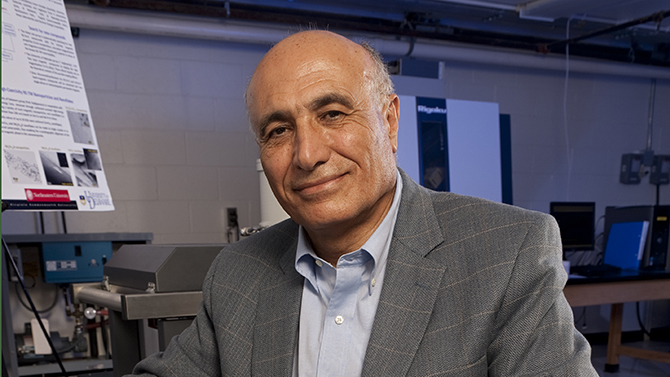


Magnet research attracts award
Photo by Evan Krape October 26, 2016
UD’s Hadjipanayis honored by international organization
George Hadjipanayis, Richard B. Murray Professor of Physics and Astronomy at the University of Delaware, has received international recognition for his outstanding contributions in the field of rare-earth permanent magnets.
Hadjipanayis was presented the inaugural Karl J. Strnat Award for his lifetime achievements at the 24th International Workshop on Rare-Earth and Future Permanent Magnets and Their Applications in Darmstadt, Germany.
“He [Strnat] was the first person to make rare-earth permanent magnets,” said Hadjipanayis, who, early in his career, worked in industry with Strnat for a few years. “I’m extremely honored to receive the first award given in his name.”
Permanent magnets produce a strong magnetic field and can be used in the production of motors, particularly in such “green energy” applications as electric vehicles and wind turbines, he said.
When Hadjipanayis was a doctoral student in the 1970s, conducting research on permanent magnets, they were made with cobalt-platinum and were therefore very expensive to manufacture. Industrial and academic researchers sought out alternative materials and began using rare-earth cobalt.
But, he said, cobalt came from the politically unstable African country then known as Zaire, and so companies again began competing to develop alternate, cobalt-free materials.
Hadjipanayis conducted pioneering work in permanent magnets that led to the discovery, with two other inventors, of rare-earth magnets made with neodymium, iron and boron, known as Nd-Fe-B magnets, and to the development of high temperature magnets. In 1983, he was the first researcher to publish a paper on Nd-Fe-B magnets.
Today, he said, most rare earths come from China, where restrictions have caused the price to skyrocket in recent years.
“There’s a lot of effort today to develop permanent magnets that use little or no rare-earth materials,” he said.
Better motors for better electric vehicles
In that research area, Hadjipanayis is part of a team that recently was awarded a grant from the U.S. Department of Energy (DOE) to develop better, less expensive motors for electric vehicles.
The three-year, $3.8 million grant from the DOE’s Vehicle Technologies Program is part of the federal “EV Everywhere” initiative launched in 2012 to make plug-in electric vehicles affordable and convenient for consumers. The grant is part of a $59.2 million federal investment in 35 research projects aimed at reducing the cost and improving the efficiency of electric, alternative-fuel and conventional vehicles, according to a DOE announcement.
Partners in the new grant, led by researchers at Iowa State University and the DOE’s Ames Laboratory, include UD and United Technologies Research Center in Hartford, Connecticut. Iowa State researchers are focusing on developing a new type of iron alloy known as “electric steel” that can be used to make motors that are lighter, more powerful and less expensive than those available today.
The research team also is seeking to address the cost of electric vehicles by developing motors that don’t rely on rare-earth magnets, the focus of Hadjipanayis’ work on the project.
More about George Hadjipanayis
Hadjipanayis, who joined the UD faculty in 1989, has received numerous awards for his work as a researcher and academic leader.
He has been named a fellow of the American Physical Society, a Humboldt fellow, an IEEE Magnetics Society Distinguished Lecturer and a recipient of the Francis Alison Award, UD’s highest competitive faculty honor.
He is the author of more than 500 publications in refereed journals and has given more than 100 invited talks and over 300 seminars and presentations at meetings and workshops.
In training the next generation of scientists and engineers in the field of magnetism, with a focus on permanent magnets and magnetic nanoparticles, he has supervised 24 doctoral students, 10 master’s degree students and more than 20 postdoctoral/research associates who are now university professors or working in industry or the public sector.
Hadjipanayis earned his bachelor’s degree from the University of Athens, Greece, and master’s and doctoral degrees from the University of Manitoba, Canada. Before coming to UD, he worked as a research scientist in industry and then joined the faculty of Kansas State University.
Contact Us
Have a UDaily story idea?
Contact us at ocm@udel.edu
Members of the press
Contact us at 302-831-NEWS or visit the Media Relations website

